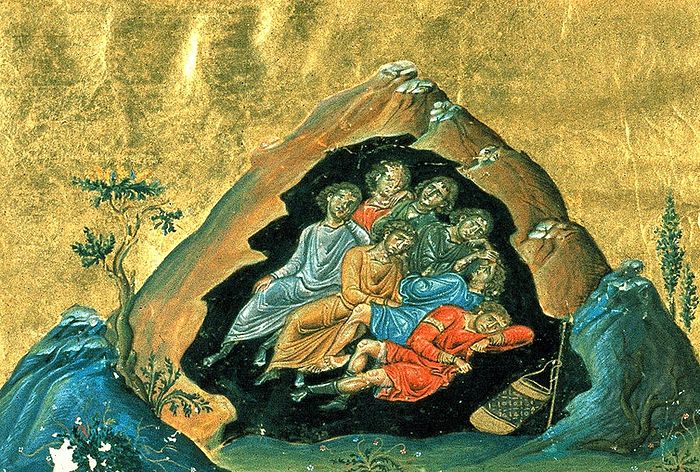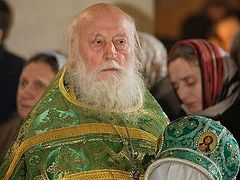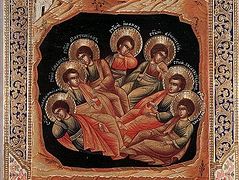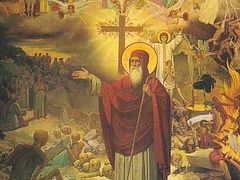A Sermon given in 1948, when once again there seemed to be absolutely no hope for the deliverance of Russia from the Communist Yoke. Published in The Orthodox Word, No. 50, May-June, 1973.
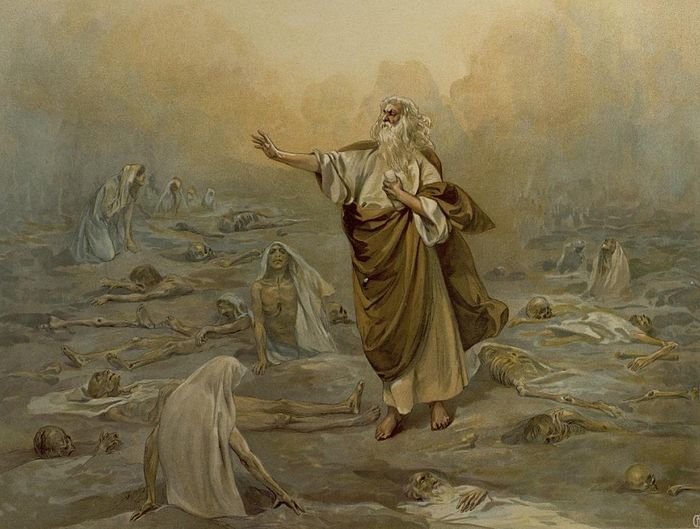 Prophet Ezekiel. Photo: hram-troicy.prihod.ru
Prophet Ezekiel. Photo: hram-troicy.prihod.ru
There was no limit to the grief and despondency of the ancient Jews when Jerusalem was destroyed and they themselves were led away into the Babylonian captivity. Where are Thine ancient mercies, O Lord, which Thou swarest to David? (Ps. 88:50), they cried out. But now Thou, hast cast off and put us to shame... They that hated us spoiled for themselves and Thou scatterest us among the nations (Ps. 43:10-12).
But when it seemed that there was no hope for deliverance, the Prophet Ezekiel, who was likewise in captivity, was made worthy of a wondrous vision. And the hand of the Lord came upon me, he says of this. The invisible right hand of the Lord placed him in the midst of a field full of human bones. And the Lord asked him: Son of man, will these bones live? And the Prophet replied: O Lord God, Thou knowest this. Then the voice of the Lord commanded the Prophet to say to the bones that the Lord will give to them the spirit of life, clothing them with sinews, flesh, and skin. The Prophet uttered the word of the Lord, a voice resounded, the earth shook, and the bones began to come together, bone to bone, each to its own joint; sinews appeared on them, the flesh grew and became covered with skin, so that the whole field became filled with the bodies of men; only there were no souls in them. And again the Prophet heard the Lord, and at His command he prophesied the word of the Lord, and from the four directions souls flew to them, the spirit of life entered into the bodies, they stood up, and the field was filled with an assembly of a multitude of people.
And the Lord said, Sun of man, these bones are the whole house of Israel; and they say, Our hope has been lost, we have perished... Behold, I will open your tombs and will bring you up out of your tombs, My people, and I wilt put My spirit within you and ye shalt live, and I will place you upon your own land (Ezekiel 37:1-14) .
Thus the Lord God revealed to Ezekiel that His promises are steadfast, and that what seems impossible to the human mind is performed by the power of God.
This vision signified that Israel, after being delivered from captivity, would return to its own land; in a higher sense, it indicated the settlement of the spiritual Israel in the eternal heavenly Kingdom of Christ. At the same time there is prefigured also the future General Resurrection of all the dead.
Therefore this prophecy of Ezekiel is read at the Matins of Great Saturday, when by His death Christ, having broken down the gates of death, opens the tombs of all the dead.
Belief in the resurrection is the cornerstone of our faith. If there be no resurrection, then is Christ not risen, and if Christ be not risen, then is your faith vain (I Cor. 15:13-14). If there is no resurrection, the whole Christian teaching is false. This is why the enemies of Christianity fight so much against faith in the resurrection, and it is likewise why the Church of Christ affirms faith in the resurrection. Many times the waves of unbelief have risen high, but they have rolled back before new signs which revealed the reality of the resurrection, of God’s bringing to life of what was acknowledged as dead.
In the 5th century, in the reign of the Emperor Theodosius the Younger, doubt in the resurrection of the dead was widespread, so that there were disputes about this even in the churches. And it was just at this time that a wondrous event occurred, the authenticity of which is confirmed by a number of historical writings.1
In the middle of the third century, in the reign of the Emperor Decius (249-251), by his decree seven youths were walled up with stones in a cave near the city of Ephesus. The son of the head of the city of Ephesus, Maximilian, and his six friends—Jamblicus, Dionysius, John, Antoninus, Martinian, and Exacustodian—confessed themselves Christians and refused to offer sacrifice to the idols. They had taken advantage of the time which had been given them for reflection, and also of the temporary absence of the Emperor, and had gone away from Ephesus and hidden in a cave in the nearby mountains, [in mountain called Ochlon]. When Decius returned and found out about this, he ordered that the entrance to the cave be walled up with stones so that the youths, deprived of food and air, might be buried alive there. Then the command of Decius had been fulfilled, two secret Christians—Theodore and Rufinus—wrote down this event on pewter plates which they hid among the stones at the entrance to the cave.
The youths who were in the cave, however, did not know what had happened. On the eve of this event, having found out about the arrival of Decius. in the city, and having prayed fervently to God, they fell asleep in a powerful and unusual sleep which lasted for about 172 years. They awoke only in the reign of Theodosius the Younger, precisely when there were disputes concerning the resurrection. At that time the owner of that place was taking out the stones that walled up the entrance to the cave and was using them for a building, without suspecting in the least that the children of whom everyone had forgotten long before were still in the cave. The youths, having awoke, thought that they had slept one night, since they did not notice any changes in the cave, and they themselves had not changed at all. One of them, the youngest, Jamblicus, who had previously gone to the city for food, having prayed to God with his friends, likewise went to Ephesus to find out whether they were being looked for, and to buy some food for themselves. He was astonished at the change, seeing churches, which, as it seemed, had not existed the day before, and hearing the name of Christ being pronounced openly. Thinking that by mistake he had come across some other city, he decided nonetheless to buy some bread here, but when for the bread he gave a coin, the bread merchant began to examine it carefully and asked where he had found the treasure. And when Jamblicus affirmed that he had found no treasure, but that he had received the money from his parents, people began to gather, and they tried to find out where he had found such old money. Jamblicus named the names of his parents and friends, but no one knew them, and finally Jamblicus heard from those present that he was really in Ephesus, that there had been no Emperor Decius for a long time, and that the Christ-loving Emperor Theodosius was reigning.
The head of the city and the bishop heard about what had happened, and in order to test the words of Jamblicus they went with him to the cave where the other six youths were, and at the entrance to the cave they discovered the pewter plates, and from them they found out when and how the youths had been in the cave. Concerning all this the head of the city immediately informed the Emperor, who personally came to Ephesus and conversed with the youths. During one of these conversations they lay down their heads and fell asleep in eternal sleep. The Emperor ordered that they be brought to the Capital, but the youths, appearing to him in sleep, commanded him to bury them in the cave where they had already slept for many years in a wondrous sleep. This was done, and during the course of many centuries their relics reposed in that cave; the Russian pilgrim of the 12th century, Anthony, describes how veneration was paid to them.
This miraculous awakening of the youths was accepted at that time as a prefiguration and confirmation of the resurrection. Everywhere the news spread about this; it is mentioned by several contemporary historians and it was spoken of at the Third Ecumenical Council, which was soon thereafter convoked in the same city. This striking miracle strengthened faith in the resurrection at that time. The power of God, which had preserved the bodies and clothing of the youths incorrupt for many years, was clearly revealed. And just as the Lord raised them from sleep, so will he gather the bones and raise the dead according to the vision of the Prophet Ezekiel.
This prophecy, which foreshadows not only the resurrection of the dead, but also the preservation from destruction of the people which keeps God’s law, was manifestly fulfilled likewise upon the Russian land.
At the beginning of the 17th century, with the dying out of the reigning house, there came upon Russia a time of troubles. The Russian land was without a government, it was torn asunder by internal rebellion, it was subjected to the attack of neighboring peoples who seized many Russian provinces and even the heart of Russia, Moscow. ‘The Russian people became fainthearted and lost hope that the Russian kingdom would continue to exist; many sought alms from foreign governments, others adhered to various pretenders and thieves who gave themselves off for crown princes.
When it seemed that there was no more Russia and only a few still hoped in her deliverance, then there resounded from a subterranean prison in the Chudov Monastery the last appeal of Patriarch St. Hermogenes who was starving there. This document, together with the epistle of Archimandrite St. Dionysius of the Holy Trinity-St. Sergius Monastery and the cellarer Abraham Palitzin, reached Nizhni-Novgorod. There the Russian people were called upon to stand up in defense of the holy things of Moscow and the House of the Mother of God.
The document moved hearts and the citizen Cosmas Minin addressed his fellow citizens from the porch of the cathedral with a flaming appeal to sacrifice everything for the fatherland. Immediately contributions poured in and an army began to be gathered. The courageous general, Michaelovich Pozharsky, was called to lead it, even though he had scarcely recovered from wounds. But while acknowledging the infirmity of human power, the Russian people gave themselves over to the protection of the Champion General, and as the greatest treasure they took with the army from Kazan the miraculous Icon of the Mother of God which had once been brought out of the earth by the holy Patriarch Hermogenes when he was still the Presbyter Hermalaus.
The Russian army moved, trusting not in its own weak power, but in the almighty help of God. And in reality there was accomplished that which until then no force had been able to accomplish. In a short time Moscow was delivered, and on the present day of the commemoration of the Seven Youths of Ephesus (October 22), the Russian army entered the Kremlin with a triumphant procession, and from the Kremlin to meet it there came another procession with the Vladimir Icon of the Mother of God which had remained in the captive city.
The Russian land was cleansed of the enemies and pretenders, the Russian kingdom was restored, and on its throne the young Michael Feodorovich Romanov ascended. Russia was resurrected, its wounds were healed, and it went from glory to glory. The Icon of the Mother of God with which Moscow had been delivered, and with it the whole Russian land, became the greatest holy object of the entire Russian people. Copies of it were placed in the capital city of Moscow, and later also in the new reigning city of St. Peter, and they likewise were glorified by a multitude of miracles. Kazan Icons of the Mother of God were to be found in every city, village, and in almost every house, and the feast of the Kazan Icon of the Mother of God was celebrated in the whole of Russia as a great feast.
Today again the Russian land has been shaken to its fonndation, and the waves of unbelief have risen high.
Grief takes possession of the heart, and in perils the Russian people is ready, like the captive Israelites, to call out: “Our bones are dry, our hope has been lost, we have perished.” But the memory of the Seven Youths who arose from sleep, together with the Meeting of the Kazan Icon of the Mother of God, proclaims the almighty right hand of God, and the word of the Prophet Ezekiel thunders from the depths of the ages with the voice of the Lord: Behold, I will open your tombs, and will bring you up Out of your tombs, My people, and will bring you into your own land, and you shall know that I am the Lord: I have spoken and will do it, saith the Lord (Ezekiel 37:12-14).
Shanghai, October 22, 1948

